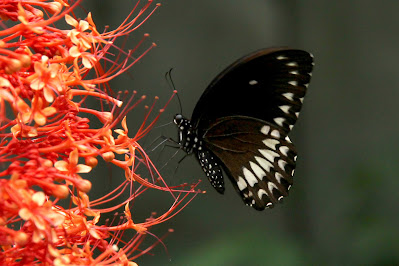Malabar Raven
Papilio dravidarum Wood-Mason, 1880 മലബാർ റാവൻ

SPECIES DETAILS
Common English Name: Malabar RavenMalayalam Name: മലബാർ റാവൻ.Tamil Name:Scientific Name: Papilio dravidarum Wood-Mason, 1880Sub Family: PapilioninaeFamily: PapilionidaeOrder: Lepidoptera
DISTRIBUTION:
Endemic to Western Ghats
STATUS:
. Not assessed. Not common.
HABITAT:
Moist deciduous forests and teak plantations with host plants and seen in altitude 300-900 M MSL
HABIT:
The Malabar raven resembles the common crow in habits and flight, but is faster than the other mimic, the common mime. It prefers shady patches. The males drink at wet patches especially in the hot dry pre-monsoon days
TYPICAL IDENTIFICATION FEATURES
The Malabar raven is a blackish-brown tailless swallowtail butterfly, about 80 to 100 mm in size. Both the sexes are similar and are mimics of the unpalatable common crow (Euploea core).
The upper forewing has a small white spot at the end of the cell (some times faded or absent), a complete series of equal sized marginal white spots in regular row and a terminal series of spots decreasing in size towards the apex.
 |
| dorsal view |
The upper hindwing has a discal series of arrow shaped white spots and submarginal series of elongated white crescent shaped markings. There is a white fringe between the veins. The outer halves of wings have a dusting of yellowish brown scales
HOST PLANTS:
Glycosmis pentaphylla (Panal), Clausena indica ( Kaattu kariveppu)
LIFE CYCLE:
There are two to three broods a year.
1. Egg:
The eggs are laid singly on the upper surfaces of the tender leaves of host plants. The newly laid egg is spherical and light green. The egg hatches in 4-5 days.
2. Catterpillers.
The little caterpillar mimics a fresh bird dropping with its olive green body and white uric acid-like markings. Total larval period is 21-25 days.
First instar larvae: instar period 3 days and grows upto 4-5 mm in length.
Second Instar Larvae: instar period 3 days and grows upto 12-14 mm in length.Body is bright greenish yellow with distinct white markings on anterior, middle and posterior segments.
Third Instar Larvae: Look like 2nd instar except the size and grows upto 24-26 mm in length.
Fourth Instar Larvae: Colour changes to bright yellow and grows upto 36-37 mm in length.
Fifth Instar Larvae:
Larvae rows upto 45-47 mm in length. Bright green colour with eye spot on thorasic region and transverse pale blue bands in abdominal segments. Pale red osemeterium also present just behind the head which erect on disturbation.

Pupa measure about 36-38 mm, greenish in colour which turns to brown. Total pupation period is 18-20 days
 |
| Pupa |
 |
| Emergence |
MORE IMAGES:

Courtesy
Write up:Wikipaedia
Images: TNHS
 |
കേരള വനം വന്യജീവി വകുപ്പ് മാങ്കുളം ഡിവിഷൻ |


















Comments
Post a Comment